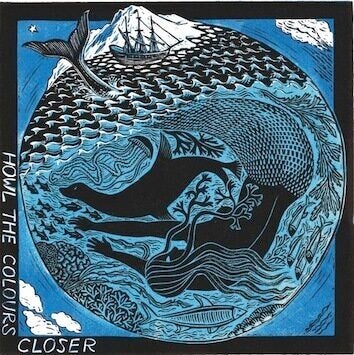The Welsh poet Susan Richardson was teaching a course on 'Intrepid Women Travellers' at Cardiff University when a reference to a Norse woman named Gudrid piqued her curiosity. Gudrid's ambitious journey from Iceland, across Greenland to Newfoundland at the start of the eleventh century is described in The Vinland Sagas.
The equally intrepid Richardson decided to follow in Gudrid's footsteps. She recorded her experiences in Creatures of the Intertidal Zone, a series of poems that charts the changing landscapes of the North and questions the nature of wilderness.
By sharing Gudrid's topography, "the environments which formed and fortified her", Richardson came to empathize with her. She started from the Snaefelsnes Peninsula in Iceland - "a thin peninsula, a bit like an arthritic finger, jutting out into the North Atlantic" - where Gudrid was born in a farm at the foot of the Snaefelsjokull volcano (now dormant). Beneath this dramatic, glacier-laden peak, Richardson was shown an ancient track through the lava that a local expert on Gudrid felt convinced she, too, would have used. "The coast alongside the lava field is made up of eccentric basalt cliff formations - caves, pillars, arches, blowholes. When I walked in this landscape, it was hard to believe that a millennium separated me from Gudrid".
At the end of her journey, off the remote northwestern tip of Newfoundland, Richardson took another step back in time. "I had the opportunity to sail along the coast on a replica Viking boat, and view the land from the sea. I imagined Gudrid huddled, night after cold cramped night, beneath her boat's half-deck, short of both food and fresh water, her skin raw with sores from wearing perpetually wet clothing. I was conscious of how easy my travels were in comparison, protected in my three-layer waterproofs."
Despite these close encounters Richardson knew that some aspects of Gudrid's experience were destined to remain "blurred and imprecise". Much of Gudrid's life is unknown to academics, but as a poet Richardson found that the absence of a firm "truth" gave her the freedom to fictionalize, "to invent, speculate and fill in the gaps".

As Richardson travelled across the Arctic she witnessed the impact of climate change. A concern for the preservation of the landscapes that Gudrid had experienced strengthened her commitment to environmental writing. She says, "I've become a passionate believer in the potential of poetry to make a difference, to inspire shifts in perception and create new patterns of thought and experience".
This concern is evident in Richardson's latest poetry collection, Where the Air is Rarefied, which examines the metaphorical significance of "the North" - a concept that resonates across different geographies and cultures. Richardson worked in collaboration with the artist Pat Gregory, drawing on a range of sources including Inuit folk tales, Icelandic sagas and polar explorers' narratives, as well as her own travels. As the collaboration progressed, Richardson found that Gregory's prints and the Arctic landscape itself had "a direct influence on the shape and structure of my writing". Her poems became "increasingly fragmented and pared-down", melting away like the ice itself; in the apocalyptic sequence, "Tip of the Ice-tongue" the poems have become footnotes to the prints.
Richardson says,"Writing about ice aroused ambivalent feelings in me. While experiencing a melancholic sense of loss, I remain fascinated by its propensity to shapeshift to liquid from solid, and by all its beautiful incarnations, be it glacier, berg, icecap or floe. I grew to relish, too, the language of ice - frazil, vuggy ice, growlers, nilas - and much as I appreciate dwarf willow and birch, muskeg and tundra, the squeak of saxifrage and the dazzle of fireweed, I came to realise that it's the whitest and most minimalist feature of the Arctic landscape that enthrals me the most".
Susan Richardson's publications are available from Cinnamon Press.
Picture credit: The Little Mermaid by Pat Gregory
29.5 x 29.5 cm unframed
Linocut and monoprint
